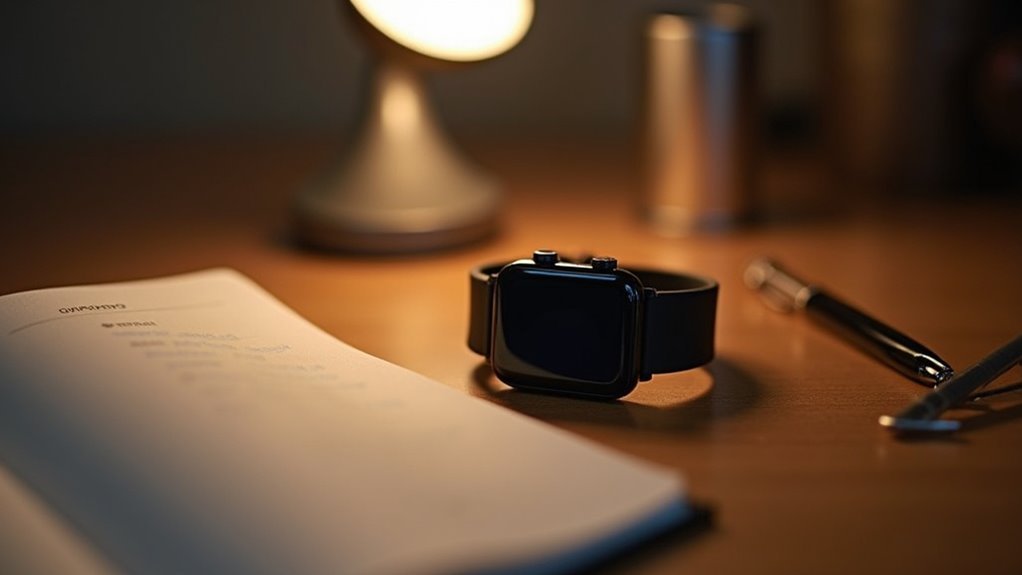Your fall detection device’s sensitivity settings directly impact your safety by determining how well it identifies actual falls versus everyday movements. Higher sensitivity (98-99%) guarantees better emergency detection but increases false alarms, while lower settings (around 80%) reduce nuisance alerts but risk missing real emergencies. You’ll need to balance detection accuracy with false alarm frequency, considering your mobility level, daily activities, and proper device placement at your waist or thigh for ideal performance and peace of mind.
Understanding Sensitivity Levels in Fall Detection Technology

When configuring fall detection systems for ideal safety, sensitivity levels serve as the cornerstone of effective monitoring.
You’ll want to understand that sensitivity represents the proportion of actual falls your system correctly identifies – fundamentally, it’s your safety net’s reliability measure.
Your system’s sensitivity directly impacts whether genuine emergencies receive proper response. While best sensitivity ranges from 98% to 99%, real-world performance often varies considerably.
optimal fall detection sensitivity of 98-99% ensures life-saving emergency response, though real-world systems often fall short of this critical benchmark
You’ll find that different fall types affect detection rates, with forward slips and trips presenting unique challenges for most systems.
Your sensor placement, movement patterns, and environmental conditions all influence sensitivity. Higher sensitivity sometimes increases false alarms, but you shouldn’t compromise on detecting actual falls.
Understanding these trade-offs helps you configure settings that balance accurate detection with manageable alert frequency. Studies show that laboratory simulated falls often fail to represent genuine emergency situations due to unrealistic testing conditions.
How Accelerometers and Gyroscopes Work Together for Accurate Detection
While accelerometers alone can detect sudden movements that might indicate falls, they’re most effective when paired with gyroscopes to create a thorough motion analysis system. Your accelerometer measures changes in acceleration across three directions, capturing rapid movements during a fall. Meanwhile, your gyroscope tracks body rotation and orientation changes, providing essential context about how you’re moving.
| What Happens | Accelerometer Detects | Gyroscope Adds |
|---|---|---|
| You trip and fall | Sudden acceleration change | Body rotation angle |
| You sit down quickly | Downward movement | Controlled orientation |
| You drop your arm | Rapid limb motion | Minimal body tilt |
Together, these sensors feed data to algorithms that distinguish between actual falls and everyday activities, dramatically reducing false alarms while ensuring real emergencies trigger alerts. The system can also incorporate data from a barometer to provide an even clearer picture of whether a fall has occurred by measuring altitude changes during the event.
Customizing Alert Response Times and Emergency Contacts

Once your device accurately detects a fall through its sophisticated sensor system, the next step involves configuring how and when it responds to emergencies.
You can customize response times to match your specific needs, with most devices averaging under a minute for emergency assistance. This speed is important—receiving help within an hour markedly improves recovery chances.
You’ll also select who gets notified when a fall occurs. Create customizable contact lists including family members, caregivers, or emergency services.
Multiple people can be informed simultaneously, ensuring someone responds quickly. Many devices feature GPS tracking, helping responders locate you even if you can’t communicate your position. Advanced systems achieve 93% accuracy in detecting actual falls while working to minimize false alarms that could lead to unnecessary emergency responses.
Two-way communication capabilities let you speak directly with contacts or emergency personnel, providing essential information about your condition and immediate needs.
Balancing False Alarm Prevention With Reliable Fall Recognition
Finding the right balance between preventing false alarms and ensuring your device catches actual falls requires careful calibration of sensitivity settings.
Calibrating fall detection sensitivity is a delicate balance between catching real emergencies and avoiding annoying false alerts.
When you increase sensitivity to catch every fall, you’ll likely experience more false alarms—potentially one every 20-40 hours. However, reducing sensitivity to minimize false alarms means you might miss actual falls, with real-world detection rates around 80%.
Your device’s placement greatly affects this balance. Chest-worn devices typically offer the best accuracy at 93-98%, while wrist-based options may trigger more false alarms.
Modern systems use AI and machine learning to improve this balance automatically. Cloud-based learning systems continuously analyze data patterns to enhance detection reliability and reduce unnecessary alerts. You can also help by providing feedback to refine settings, participating in regular testing, and working with monitoring centers to optimize your device’s performance for your specific activity patterns.
Optimizing Device Placement and Calibration for Maximum Safety

When you’re setting up your fall detection device, placement location can make the difference between life-saving accuracy and frustrating false alarms. Your waist or thigh offers ideal positioning since they’re closest to your body’s center of gravity, delivering sensitivity rates up to 97.5% with 96.9% specificity.
While multiple sensors increase accuracy, you’ll likely find better compliance with a single, well-placed device. If you choose upper body placement like your shoulder, it’s most effective when combined with lower body sensors for thorough fall direction classification.
Understanding fall direction helps medical professionals determine the specific type of injuries you may have sustained and guides appropriate treatment decisions. Proper calibration is equally vital. You’ll need algorithms that account for your mobility level, daily activities, and environmental factors like clothing.
This guarantees your device distinguishes between actual falls and routine movements, reducing false positives while maintaining reliable protection.
Frequently Asked Questions
How Long Does the Battery Typically Last on Fall Detection Devices?
Fall detection devices typically offer 20-24 hours of battery life, though some last up to 10 days. You’ll find shorter battery life because fall detection and GPS features consume more power than basic alert systems.
Can Fall Detection Devices Work Underwater or in the Shower?
Most fall detection devices don’t work reliably underwater or in showers. Water interferes with sensors and signals, causing missed alerts or false alarms. You’ll need specialized waterproof devices with modified algorithms for wet environments.
What Happens if I’m Unconscious and Can’t Respond to Alerts?
If you’re unconscious after falling, advanced algorithms detect your unresponsiveness and automatically trigger emergency protocols. The system immediately contacts monitoring centers, who’ll notify caregivers or emergency services without requiring your response.
Do Fall Detection Devices Work Properly During Airplane Travel?
Fall detection devices haven’t been specifically tested during flights. Turbulence, cabin pressure, and limited connectivity can trigger false alarms or prevent alerts from reaching emergency contacts, reducing their reliability.
Can Multiple Family Members Receive Alerts From One Fall Detection Device?
Yes, you can set up multiple family members to receive alerts from one fall detection device. Most devices simultaneously notify all designated contacts through texts, calls, and app notifications until someone responds to your emergency.
In Summary
You’ll maximize your fall detection device’s effectiveness by fine-tuning these critical settings to match your lifestyle and mobility patterns. Don’t settle for default configurations—adjust sensitivity levels, response times, and contact preferences based on your specific needs. Remember that proper device placement and regular calibration updates guarantee you’re getting the most reliable protection possible. Take time to test your settings periodically so you can trust your device when it matters most.





Leave a Reply